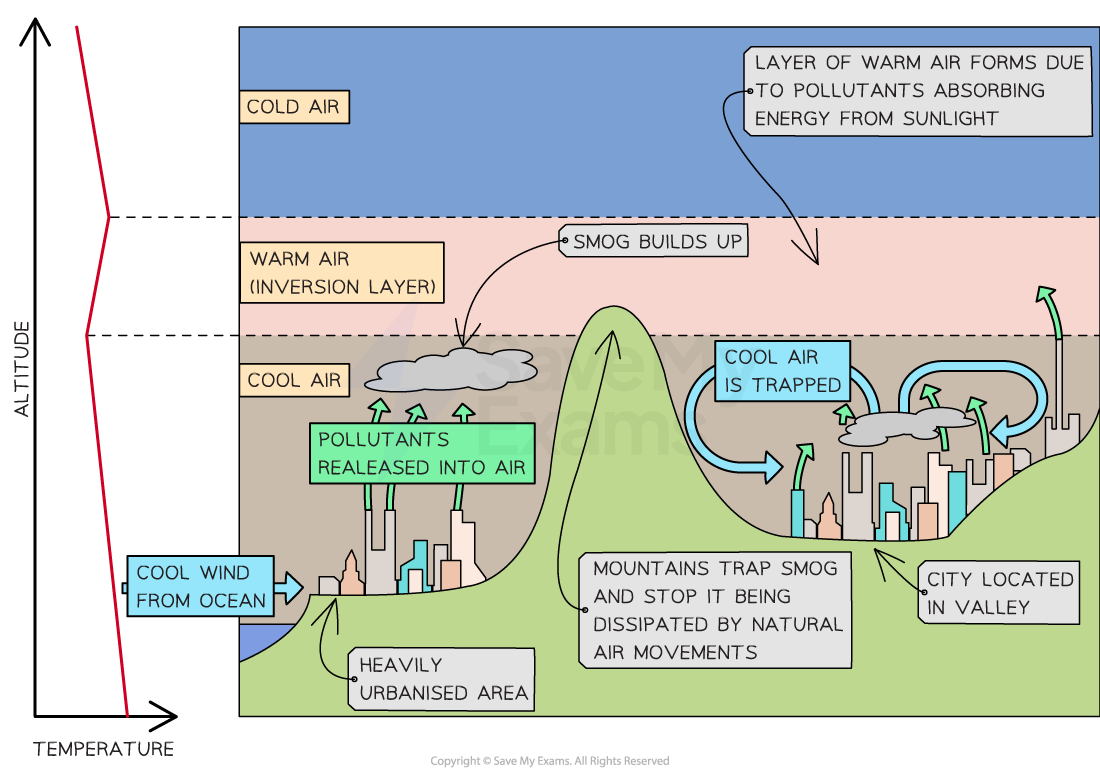Smog
What is Smog?

Photo by Mikel Letona on Unsplash
Only the highest city buildings protrude above this smog, which has been trapped in the cooler air near ground-level by a layer of warm air above the city
- Smog is a type of air pollution characterised by a complex mixture of primary and secondary pollutants
- Tropospheric ozone is a major component of smog
- Deforestation and burning of biomass release large amounts of particulate matter, volatile organic compounds, and other pollutants into the atmosphere
- These emissions can contribute to the formation of smog by increasing the concentration of primary pollutants and providing additional reactive substances for secondary pollutant formation
- To some extent, forested areas can act as natural sinks for air pollutants, so their removal can exacerbate smog formation in surrounding regions
Factors Influencing Smog Occurrence
- The frequency and severity of smog depend on the local topography, climate conditions, population density, and the amount of fossil fuel use in an area
- Areas with geographical features that inhibit air movement, such as valleys or basins, can experience higher levels of smog due to the accumulation of pollutants
- Regions with hot and sunny climates are also more susceptible to smog formation as sunlight contributes to the chemical reactions that produce ozone
Thermal Inversions
-
- Thermal inversions occur when a layer of cool, dense air becomes trapped beneath a layer of warmer, less dense air
- Inversion conditions prevent the vertical mixing of air and hinder the dispersion of pollutants, leading to their accumulation near the ground
- This trapped layer of pollutants can contribute to the formation and persistence of smog, especially in areas with stable atmospheric conditions

Thermal inversions can cause a serious build up of smog in urban areas that are located in basins and valleys
Economic Losses
- Economic losses caused by urban air pollution can be significant due to various reasons:
Healthcare Costs
-
- Poor air quality in urban areas leads to an increase in respiratory and cardiovascular diseases among the population
- This results in higher healthcare costs for individuals, businesses, and governments
- The treatment of pollution-related illnesses, including hospitalisations, medications, and long-term care, can put a strain on healthcare systems and result in substantial economic burdens
Reduction in Productivity
-
- Air pollution can have a detrimental effect on worker productivity
- Exposure to polluted air can lead to respiratory issues, allergies, and fatigue, all of which can impair work performance
- Reduced productivity levels translate into economic losses for businesses and the overall economy
Loss of Workdays
-
- Severe air pollution episodes often trigger health warnings, prompting people to stay indoors or limit outdoor activities
- This can result in missed workdays or reduced working hours, impacting businesses and individuals' incomes
- Additionally, when pollution-related health issues force workers to take sick leave, it affects productivity and leads to economic losses
Environmental Damage
-
- Urban air pollution not only affects human health but also causes environmental damage
- Contaminated air can harm vegetation, crops, and ecosystems, leading to reduced agricultural yields, damage to natural resources, and disruption in the ecological balance
- These impacts can result in economic losses for industries reliant on agriculture, forestry, and tourism
Decreased Property Values
-
- Areas with high levels of air pollution often experience a decline in property values
- Potential buyers and investors are deterred by the health risks associated with living or operating businesses in polluted areas
- This reduction in property values can have negative economic consequences for homeowners, real estate developers, and local governments
Increased Environmental Regulations
-
- To combat air pollution, governments may impose stricter environmental regulations on industries, businesses, and vehicles
- Compliance with these regulations often requires investments in pollution control technologies, infrastructure upgrades, and cleaner energy sources
- These expenses can place a financial burden on businesses and potentially impact their profitability
- Tackling air pollution not only improves public health but also brings economic benefits by reducing these losses and creating a healthier and more sustainable environment for communities

